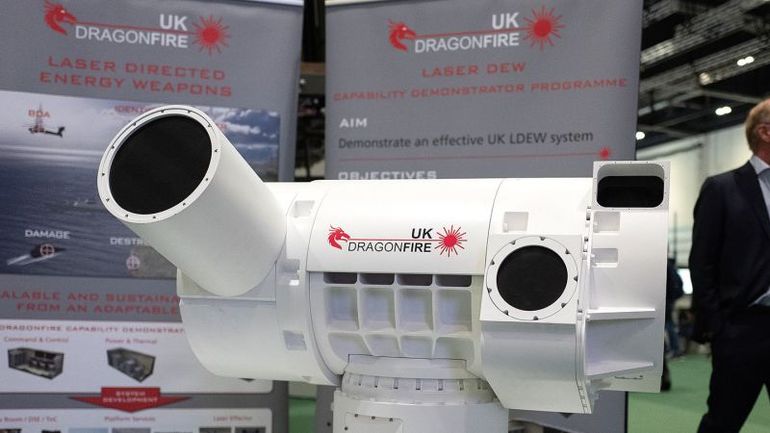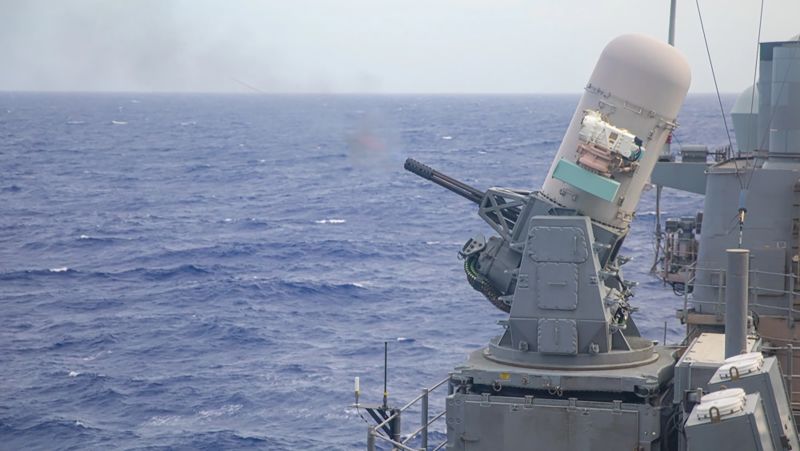
The Future of Military Defense: How Laser Technology is Transforming Air Defense Strategies

Discover how laser technology is changing the game in military defense as countries like Britain unveil cost-effective laser weapons capable of countering enemy missiles and drones. Learn how these lasers offer lethal defense at a fraction of the cost of traditional missile interceptors, potentially saving millions in defense spending.
Britain recently unveiled a new laser weapon that their military claims could provide effective defense against missiles or aircraft at a cost of around $13 per shot. This new technology has the potential to save tens of millions of dollars compared to current missile interceptors.
A video released by the United Kingdom's Defense Ministry showcased a test of the DragonFire, a laser directed energy weapon (LDEW) system. The successful demonstration took place in Scotland in January, where the laser was used to target and intercept an aerial threat.
"It's a potential game changer for air defense," the video showcases a bright laser beam piercing the night sky over a firing range in the remote Hebrides archipelago, forming a ball of light upon hitting its target.
According to the Defense Ministry, the DragonFire has the capability to accurately hit a target as small as a coin "over long ranges." However, specific details about the weapon's exact range are classified.
The UK Defense Ministry stated that the laser beam has the ability to cut through metal, potentially causing structural failure or other significant impacts if aimed at the warhead.
Furthermore, it is claimed that the laser beam can eliminate targets at a significantly lower cost compared to current air defense missiles.
The Defense Ministry has estimated that firing a 10-second laser burst costs approximately $13. This is significantly cheaper compared to the Standard Missile-2 used by the United States Navy for air defense, which costs over $2 million per shot.
The DragonFire laser weapon underwent testing in January at a British firing range.
UK Defense Ministry
“It has the potential to be a long-term low-cost alternative to certain tasks missiles currently carry out,” a January statement from the UK Defense Ministry said.
The cost of air defense missiles has become a popular topic in defense discussions lately. This is due to the effectiveness of low-cost drones on battlefields in Ukraine and in attacks by Houthi rebels on ships in the Red Sea and Gulf of Aden.
Analysts are wondering how long the US, UK, and their allies can continue to use multi-million-dollar missiles against Houthi drones that can be obtained for less than $100,000 in some cases.
Meanwhile expensive air defense systems from Western allies have been crucial to Ukraine’s ability to defend itself from attacks by Russian missiles and drones.
A UK Dragonfire laser directed energy weapon system at the DSEI arms fair at ExCel on September 10, 2019 in London, England.
A UK Dragonfire laser directed energy weapon system at the DSEI arms fair at ExCel on September 10, 2019 in London, England.
Leon Neal/Getty Images
James Black, assistant director defense and security for the RAND Europe think tank, highlighted in a blog post that the shift to low-cost drones and rockets has changed the balance between offense and defense. This change benefits those who deploy a high number of inexpensive unmanned systems and munitions to overpower advanced air and missile defenses.
Black also mentioned that DragonFire has the potential to tilt this balance back in favor of the UK.
UK Defense Secretary Grant Shapp stated in January that this advanced weaponry has the capability to transform the battlefield by decreasing the need for costly ammunition.
However, it is important to note that this technology is still unproven and has certain limitations.
However, Black and others point out that lasers such as DragonFire have not yet been proven effective in real combat situations and may have restrictions.
In a recent article for The Conversation, Iain Boyd, who is the director of the Center for National Security Initiatives at the University of Colorado, highlighted a few issues with lasers.
Rain, fog, and smoke can scatter light beams and reduce their effectiveness. Laser weapons generate a significant amount of heat, therefore necessitating large cooling systems. Mobile lasers, which are often mounted on ships or aircraft, will require regular battery recharges. In order to successfully burn holes in moving targets, the lasers must remain locked on for up to 10 seconds, as explained by Boyd.
An illustration of the HELMA-P drone neutralization. The HELMA-P laser effector is a response to the threat posed by UAVs and in particular mini UAVs. Its mission will be to secure operations on national territory during events and to support external operations by identifying, tracking and neutralizing the fixed or agile threat. The system is offered in fixed or vehicle-integrated configurations and is compatible with a C2 (Command and Control) process or a BMS (Battle Management System).
The HELMA-P drone neutralization illustration shows how the HELMA-P laser effector responds to the threat of UAVs, especially mini UAVs. Its main goal is to protect operations within the country during events and assist in external operations by detecting, monitoring, and disabling both stationary and moving threats.
The system is offered in fixed or vehicle-integrated configurations and is compatible with a C2 (Command and Control) process or a BMS (Battle Management System).
Cilas Ariane Group
Related article
French government orders laser weapon prototype for Paris Olympics
The British were not the pioneers in creating a laser capable of shooting down aerial targets.
In 2014, the Navy conducted a successful test and implementation of a laser weapon system on the USS Ponce in the Persian Gulf.
The Navy tested a more advanced laser system on the USS Portland in 2020 and 2021. The system was capable of engaging drones, small aircraft, and small boats.
According to Rear Adm. Fred Pyle, director of the Navy’s Surface Warfare Division, a laser system was installed on the guided-missile destroyer USS Preble in 2022. The system is currently undergoing testing, as reported by Breaking Defense in a January symposium.
Ticonderoga-class guided-missile cruiser USS Antietam (CG 54) fires a Phalanx Close-In Weapon System (CIWS) during a live-fire exercise, Philippine Sea, on June 6, 2022.
Ticonderoga-class guided-missile cruiser USS Antietam (CG 54) fires a Phalanx Close-In Weapon System (CIWS) during a live-fire exercise, Philippine Sea, on June 6, 2022.
Santiago Navarro/U.S. Navy
Related article
In 2022, a Houthi missile came dangerously close to hitting a US warship. Fortunately, the Navy was able to deploy its 'last line of defense'.
During the same year, the US Navy conducted a successful test of a high-energy laser system against a target simulating a cruise missile.
The Navy mentioned that the test did not include a plan to give the laser weapon to warfighters, stating that it provides a preview of future laser technology.
In a report from 2023, the US Government Accountability Office (GAO) acknowledged the Pentagon's achievements in testing laser weapons. However, the report also highlighted the need for the Pentagon to do more in terms of getting these weapons to troops. This includes determining their specific roles and developing strategies for acquiring them.
The GAO report highlighted a longstanding issue within the Department of Defense known as the "valley of death" that hinders the transition of technology between development and acquisition communities.
British defense leaders emphasize the urgent need to deploy lasers on the modern battlefield and stress the importance of acting swiftly to make it happen.
Shimon Fhima, director of strategic programs for the UK Defense Ministry, stated that in a constantly changing world with new threats emerging, their priority is to provide the necessary tools to support the soldiers. He also emphasized the importance of speeding up the process to move forward in the next phase of operations.
Editor's P/S:
This new laser weapon











